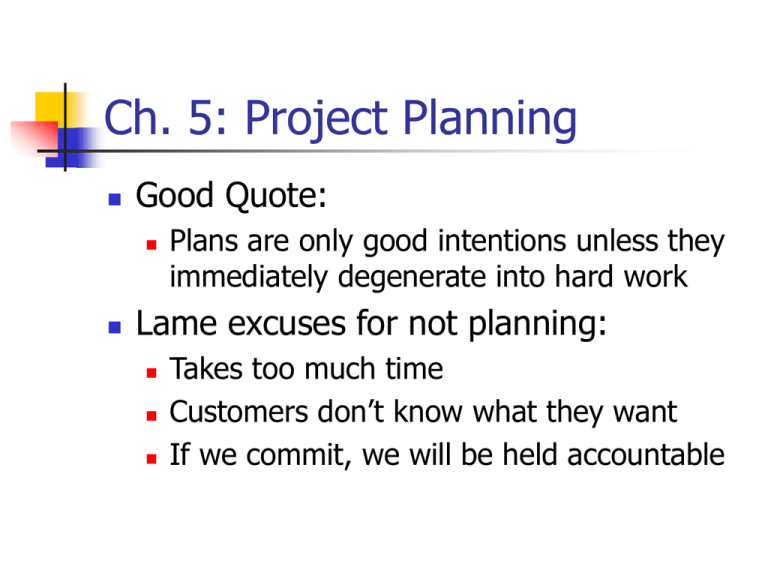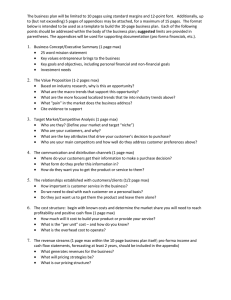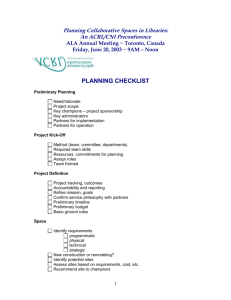Project Planning
advertisement

Ch. 5: Project Planning Good Quote: Plans are only good intentions unless they immediately degenerate into hard work Lame excuses for not planning: Takes too much time Customers don’t know what they want If we commit, we will be held accountable Ch. 5.0: Reasons for Project Planning Establish directions for project team Support objectives of parent organization Make allowance for risk Put controls on the planned work Ch. 5.0: Project Planning in Information Systems View of several authors in the field of IS: Popularized Name Planning Process “Units” Breakdown System Development Life Cycle (SDLC) 4 to 6 or 7 “phases” (no name) 7 “steps” (no name) 6 “planning sequences” Ch. 5.0: Contents of Project Planning Chapter Initial project coordination Systems integration Sorting out the project Work breakdown structure (WBS) and linear responsibility charts Interface coordination through integration management Ch. 5.1: Initial Project Coordination: Senior Management’s Role Delineate the firm’s intent Outline scope of project Describe how project’s results reinforce firm’s goals Ch. 5.1 The Project Launch Meeting Project Launch Meeting = Visible symbol of top management’s commitment to the project Ch. 5.1 Major Issues at Project Launch Meeting Existence of well-defined set of project objectives Precise nature of scope statement Uniqueness of project Ch. 5.1: Detail/Length of Project Launch Meeting For routine projects: “Touch base”, short meeting Unique projects: Extensive discussion Ch. 5.1: Potential Traps for Project Launch Meeting Trap Effect Go deeper than “most aggregated level” (level 1) Make ballpark estimate of budget and time No team integration Preliminary estimate gets cast in stone Ch. 5.1: Expected Outcome of Project Launch Meeting Establish technical scope Participants accept performance responsibility Tentative overall schedules and budgets Creation of a Risk Management Group Ch. 5.1: Major Risks Considered at Project Planning Initiation Market reaction to new process/product Project being stopped due to patent awarded to a competing innovation Ch. 5.1: Risk Management Plan Includes: Project technology Project schedule Project resource base Myriad of other risk factors Makeup of project risk management group Ch. 5.1: Composite Plan Combination of Risk Management Plan and Project Launch Meeting action items Approved by all participating functional groups Endorsed by PM and sent up the management ladder for approval Ch. 5.1: From Composite Plan to Project (Master) Plan Modify composite plan with written “change orders” Approve updated plan with functional unit involved and senior management Iterate this process until no more changes are proposed Hold post-planning review meeting Ch. 5.1: Carefully Determine Set of Deliverables! Typical Scenario: 1. 2. 3. Marketing over-promises deliverables Engineering may not be able to produce deliverable on time Marketing is unable to deliver on time Ch. 5.1: Marketing’s Objections to Early Involvement of Engineering Style Cost Probably true Probably false Sales specialists know firm’s products and services Sales specialists know about cost, designs and lead times Engineers are argumentative Cost of bringing engineers to a meeting drives up sales cost Ch. 5.1: Why Involve the Customer in Planning? Easier Faster Give customer a voice Cheaper (to do things right the first time) Ch. 5.1: Multifunctional Teams (Concurrent Engineering) Used when a system must be installed in a larger, more complex system Integrates through cross functional groups Ch. 5.1: Project Plan Elements Overview Objectives General approach Contractual aspects Schedules Resources Personnel Evaluation methods Potential problems Ch. 5.1: Project Charter Generated through negotiations involving the many parties at interest in the project Ch. 5.1: Classic SDLC (Left) vs. Aaron et. al. Model (Right) Feasibility Analysis Design Build Closure Ongoing Use Concept Evaluation Requirement Identification Design Implementation Test Integration Validation Customer Test and Evaluation Operations and Maintenance Ch. 5.2: Three Main Objectives of Systems Integration Performance Effectiveness Cost Ch. 5.3: Even Planning Process a) b) c) Make list of activities of similar importance in sequential order Level 1 Break each level 1 process into subprocesses as under a) Level 2 Continue to lower process levels until no further breaking is possible Ch. 5.3: Illustration of “Even Planning Process” Ch. 5.3: Form Useful for “Even Planning Process” Ch. 5.3: Tree Diagram Used in Hierarchical Planning Ch. 5.3: Strategic Factors in Project Planning Project mission Top management support Project’s action plan Ch. 5.4: Example of a Work Breakdown Structure (WBS) Ch. 5.4: Steps in Designing a WBS List task breakdown in succeedingly finer levels Construct a responsibility matrix Establish pricing control Schedule milestones Identify problems Generate Project Master Schedule Ch. 5.4: Linear Responsibility Chart Ch. 5.5: Planning and Design using Multidisciplinary Teams Generate integrated base for project design Add software for conflict detection Add software to generate production plan Generate knowledge base Ch. 5.5: Example of Interface Map Ch. 5.5: Project Phases and Phase Gates in the SDLC Feasibility System Requirement Specifications Design Project Proposal Design Specs Build Programmer’s and User’s Manuals Ch. 5.5: Coordination Structure Model of Project Management








